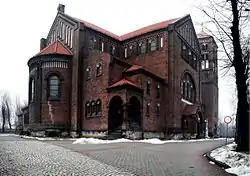Ruda, Ruda Śląska
Ruda (German: Ruda) is a district in the North-West of Ruda Śląska, Silesian Voivodeship, Southern Poland. It has an area of 11.9 km2 and in 2006 it was inhabited by 23,134 people.[1]
Ruda | |
|---|---|
 Saint Joseph church | |
 Location of Ruda within Ruda Śląska | |
| Coordinates: 50°18′42″N 18°51′05″E | |
| Country | |
| Voivodeship | Silesian |
| County/City | Ruda Śląska |
| Area | |
| • Total | 11.9 km2 (4.6 sq mi) |
| Population (2006) | |
| • Total | 23,134 |
| • Density | 1,900/km2 (5,000/sq mi) |
| Time zone | UTC+1 (CET) |
| • Summer (DST) | UTC+2 (CEST) |
| Area code | (+48) 032 |
History
The village was first mentioned in a Latin document of Diocese of Wrocław called Liber fundationis episcopatus Vratislaviensis from around 1305 as item in Ruda sunt L mansi parvi, de quibus scultetus habet VI), alii deserviunt domino episcopo. Decima de omni grano. Et scultetus solvit ) marcam de molendino suo..[2][3] The village belonged initially to the Duchy of Bytom, a fee of the Kingdom of Bohemia, which after 1526 became a part of the Habsburg monarchy. After the Silesian Wars the area became a part of the Kingdom of Prussia. Between 1816 and 1908 the biggest Zinc smelter in Europe, "Carlshütte", operated in Ruda. It was accompanied by numerous other industrial establishments.
After World War I in the Upper Silesia plebiscite 6,212 out of 10,352 voters in Ruda voted in favour of joining Poland, against 4,105 opting for staying in Germany.[4] Afterwards it became a part of Silesian Voivodeship, Second Polish Republic. It was then annexed by Nazi Germany at the beginning of World War II. After the war it was restored to Poland.
Ruda received town rights in 1939, in effect after World War II. In 1951 Godula, Orzegów and Chebzie were amalgamated with Ruda,[5] and on December 31, 1958 it was merged with the town Nowy Bytom to form the modern Ruda Śląska.[6]
References
- "Tab. 5 Gęstość zaludnienia w poszczególnych dzielnicach". Lokalny Program Rewitalizacji Miasta Ruda Śląska na lata 2007-2015 (PDF) (in Polish). Ruda Śląska: Urząd Miasta Ruda Śląska. September 2007. p. 8.
- Schulte, Wilhelm (1889). Codex Diplomaticus Silesiae T.14 Liber Fundationis Episcopatus Vratislaviensis (in German). Breslau.
{{cite book}}: CS1 maint: location missing publisher (link) - "Liber fundationis episcopatus Vratislaviensis" (in Latin). Retrieved 13 July 2014.
- "Results of the Upper Silesia plebiscite in Hindenburg/Zabrze County" (in German). Retrieved 2015-05-03.
- Rozporządzenie Rady Ministrów z dnia 17 marca 1951 r. w sprawie zniesienia i zmiany granic niektórych powiatów oraz utworzenia i zmiany granic niektórych miast, stanowiących powiaty miejskie w województwie katowickim., Dz. U. z 1951 r. Nr 18, poz. 147
- Rozporządzenie Rady Ministrów z dnia 18 listopada 1958 r. w sprawie utworzenia miasta Ruda Śląska stanowiącego powiat miejski w województwie katowickim., Dz. U. z 1958 r. Nr 69, poz. 342